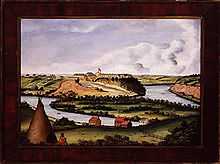Pike Island

Pike Island, Dakota name Wita Tanka, is an island at the confluence of the Mississippi and Minnesota Rivers in the southwestern part of St. Paul in the Twin Cities metropolitan area of Minnesota, USA. The island is now part of Fort Snelling State Park. It is a portion of the 100,000 acres (400 km2) of land purchased from the Mdewakanton Sioux Indians by Zebulon Pike in September 1805. Pike's Purchase was later to become Fort Snelling, Minneapolis, and St. Paul.[1] The U.S. government wanted to build a fort to protect American interests in the fur trade in the region, and Pike negotiated the treaty. Pike valued the land at $200,000, but the U.S. Senate later agreed to pay only $2000.[1]
In 1819 Colonel Henry Leavenworth invited Jean-Baptiste Faribault, a French Canadian, and his family to settle on Pike Island near the new fort to help promote the fur trade.[2] An 1821 treaty gave ownership of Pike Island to Elizabeth Pelagie Ferribault, a Dakota Indian, and wife of Jean-Baptiste Faribault.[3][4]
The six-week Dakota War of 1862 resulted in the deaths of hundreds of settlers and Indians. After the conflict more than 400 Dakotas were tried, and 302 men condemned to be executed at Mankato, Minnesota. President Lincoln eventually commuted the sentences of all but 38 Dakota, who were hanged in a mass execution on December 26, 1862.

During this time more than 1600 Dakota women, children, and old men were held in an internment camp on Pike Island. Living conditions were poor, and disease struck the camp, killing more than three hundred.[5] In May 1863, the survivors were forced aboard steamboats and relocated to Crow Creek in the southeastern Dakota Territory, a place stricken by drought at the time. The survivors of Crow Creek were moved three years later to the Santee Sioux Reservation in Nebraska.[6][7]
References
- ↑ 1.0 1.1 "The Treaty Story". Minnesota Territory. Minnesota Historical Society. Retrieved 2006-12-12.
- ↑ "Alexander Faribault". City of Faribault Heritage Preservation Commission. 2003. Retrieved 2006-12-12.
- ↑ Krahn, Lisa A. "Was Jean-Baptiste A Spy?". Upper Mississippi Brigade Articles. Upper Mississippi Brigade. Retrieved 2006-12-12.
- ↑ Ska, Kunsi. "A Family Outing". Retrieved 2006-12-12.
- ↑ Monjeau-Marz, Corinne L. (October 10, 2005). Dakota Indian Internment at Fort Snelling, 1862–1864. Prairie Smoke Press. ISBN 0-9772718-1-1.
- ↑ "Where the Water Reflects the Past". The Saint Paul Foundation. 2005-10-31. Retrieved 2006-12-12.
- ↑ "Family History". Census of Dakota Indians Interned at Fort Snelling After the Dakota War in 1862. Minnesota Historical Society. 2006. Retrieved 2006-12-12.
Coordinates: 44°53′32″N 93°09′55″W / 44.89222°N 93.16528°W